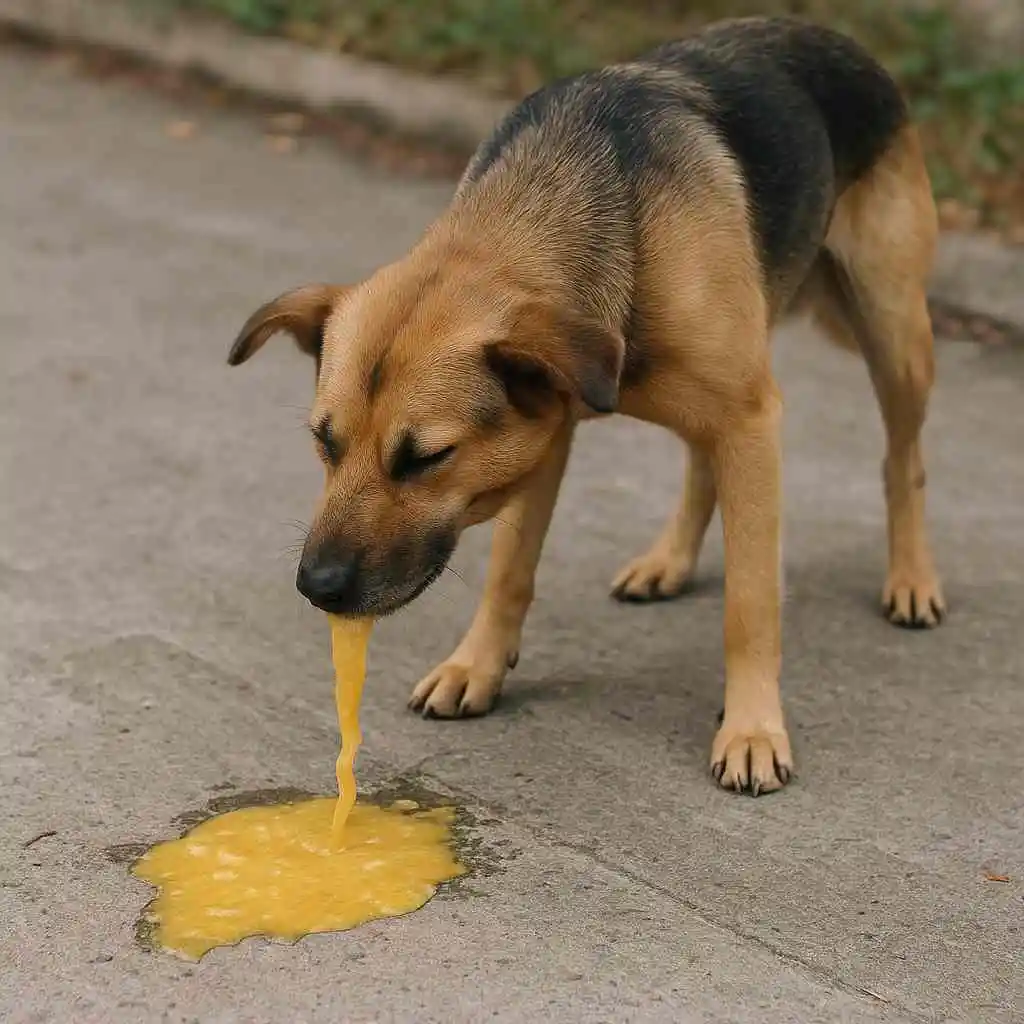Dog Throwing Up Yellow: Causes, Risks, Treatment & Prevention Guide
When a dog throws up yellow fluid, the color typically comes from bile, a digestive substance produced by the liver and stored in the gallbladder. Yellow vomiting in dogs is common, but it can signal anything from simple hunger to underlying medical disorders. This guide explains every major cause, how to respond, when to see a veterinarian, and what you can do to prevent future episodes.

What Is Yellow Vomit in Dogs?
Yellow vomit is most often a mixture of stomach acid and bile. Dogs release bile into the small intestine to break down fats during digestion. When the stomach is empty or irritated, bile may reflux upward and trigger vomiting. The sight is alarming, but identifying the pattern and trigger helps determine the seriousness of the condition.
Major Causes of Yellow Vomiting in Dogs
1. Bilious Vomiting Syndrome (Empty Stomach Vomiting)
Bilious vomiting syndrome (BVS) occurs when bile irritates an empty stomach. It happens most often early in the morning or late at night.
Typical symptoms include:
-
Yellow or yellow-green fluid
-
Gagging before breakfast
-
Normal behavior between episodes
Dogs that eat once per day or go long hours without meals experience BVS more often because their stomach remains empty for extended periods.
2. Hunger or Irregular Feeding Patterns
Long periods without food increase acid production. Excess acid irritates the stomach lining, leading to yellow vomit. Puppies and small-breed dogs are especially sensitive because they metabolize food quickly.
3. Dietary Indigestion
Dogs often vomit yellow after eating something unusual. Common triggers include:
-
Table scraps
-
Spoiled food
-
Rapid diet changes
-
Garbage or outdoor debris
-
Treats with artificial dyes or preservatives
The stomach reacts by expelling irritants, and bile may appear in the vomit.
4. Food Allergies or Intolerances
Some dogs cannot tolerate certain proteins, grains, or additives. Chronic irritation of the stomach or intestines can cause:
-
Yellow vomit
-
Loose stool
-
Gas
-
Skin itching
Common allergy foods include chicken, beef, dairy, corn, and wheat.
5. Gastritis
Gastritis means inflammation of the stomach lining. It may be caused by:
-
Toxic plants
-
Chemicals
-
Human medications
-
Fatty foods
-
Bacterial imbalance
Dogs with gastritis may vomit bile repeatedly and show reduced appetite.
6. Intestinal Blockages
A foreign object can obstruct the stomach or intestines and cause bile-stained vomit.
High risk objects include:
-
Socks
-
Toys
-
Bones
-
Rocks
-
Fabric
Blockages require immediate veterinary attention.
7. Pancreatitis
Pancreatitis is inflammation of the pancreas. It is serious and painful.
Common signs include:
-
Yellow vomit
-
Diarrhea
-
Hunched posture
-
Abdominal pain
-
Lethargy
High fat meals and table scraps are common triggers.
8. Liver or Gallbladder Disease
When the liver or gallbladder cannot regulate bile properly, dogs may vomit yellow fluid. Other signs may include jaundice (yellow eyes or gums), weight loss, and weakness. Diagnostic tests are required to identify organ related issues.
9. Intestinal Parasites
Hookworms, roundworms, and giardia can all irritate the digestive tract. Some dogs respond with yellow vomiting, especially if the infection is severe.
10. Motion Sickness
Car rides can disrupt the stomach, causing nausea and bile vomiting—especially in young dogs or anxious dogs.
Symptoms That Accompany Yellow Vomit
Yellow vomiting is often only one part of a bigger picture. Additional signs help determine the seriousness.
Common associated symptoms include:
-
Drooling
-
Lip licking
-
Abdominal gurgling
-
Lethargy
-
Diarrhea
-
Loss of appetite
-
Restlessness
-
Dehydration
If more than one warning sign appears, the cause may be medical rather than simple hunger.
When Yellow Vomiting Is an Emergency
Seek immediate veterinary attention if your dog shows:
-
Persistent vomiting (more than twice in 24 hours)
-
Blood in vomit
-
Swollen or hard abdomen
-
Severe diarrhea
-
Weakness or collapse
-
Inability to keep water down
-
Signs of pain
These symptoms can indicate blockages, pancreatitis, or organ disease.
What To Do If Your Dog Is Throwing Up Yellow
1. Monitor Behavior and Frequency
A single episode may not require treatment. Multiple episodes in a short period suggest a deeper issue.
2. Offer a Short Fasting Period
Adult dogs can fast for 8-12 hours to settle the stomach.
Do NOT fast puppies, small breeds, or dogs with health conditions.
3. Provide Small, Bland Meals
After fasting, offer:
-
Plain boiled chicken
-
Plain boiled turkey
-
Lean ground beef (fat removed)
-
White rice
-
Pumpkin puree (not pie filling)
Start with small portions to avoid overwhelming the stomach.
4. Add a Bedtime Snack
A small snack before sleep prevents nighttime bile accumulation and reduces morning vomiting.
5. Keep Water Accessible
Dogs must stay hydrated. Offer small frequent sips if vomiting continues.
6. Review Diet And Feeding Schedule
Feed two to three smaller meals instead of one large daily meal. Ensure quality ingredients. Avoid artificial preservatives and high fat foods.
7. Observe for Foreign Object Ingestion
If your dog swallowed something unusual, do not wait. A blockage is life-threatening.
8. Visit a Veterinarian
If vomiting persists or recurs, your vet may perform:
-
Blood tests
-
X rays
-
Ultrasound
-
Fecal parasite screening
-
Allergy testing
Treatment depends on the diagnosis.
Long Term Prevention Strategies
Dietary Prevention
-
Feed consistent meals at regular times.
-
Select high quality food with easily digestible proteins.
-
Avoid abrupt food changes.
-
Do not feed table scraps.
Environmental Prevention
-
Keep trash locked.
-
Remove toxic plants.
-
Supervise outdoor time.
-
Use appropriate chew toys.
Health Prevention
-
Maintain routine deworming.
-
Schedule yearly vet exams.
-
Monitor chronic conditions such as pancreatitis or allergies.
See More: Tooth Sensitive Toothpaste: Complete Guide to Relief, Protection, and Science
Causes of Yellow Vomit & How Serious They Are
| Cause | Severity | Key Signs | Action |
|---|---|---|---|
| Bilious Vomiting Syndrome | Mild | Morning yellow vomit | Feed smaller meals |
| Hunger/Empty Stomach | Mild | Vomiting before meals | Adjust feeding schedule |
| Diet Issues | Mild to Moderate | Mild nausea | Add bland diet |
| Food Allergies | Moderate | Itching, gas, diarrhea | Try elimination diet |
| Gastritis | Moderate | Lethargy, discomfort | Vet evaluation |
| Blockage | Severe | Repeated vomiting, pain | Emergency vet care |
| Pancreatitis | Severe | Diarrhea, hunched back | Immediate medical attention |
| Liver Issues | Serious | Jaundice, weakness | Diagnostic testing |
| Parasites | Mild to Moderate | Sudden vomiting | Deworming required |
| Motion Sickness | Mild | Nausea in the car | Anti-nausea meds |
Home Remedies for Mild Yellow Vomiting
-
Offer bland food for 24–48 hours
-
Provide probiotics approved for dogs
-
Add pumpkin for digestion support
-
Give frequent small meals
-
Ensure clean, fresh water supply
Preventive Feeding Strategies
-
Feed 2-3 meals per day
-
Include a light bedtime snack
-
Avoid long fasting intervals
-
Gradually transition between foods
-
Select low-fat, high-digestibility formulas
See More: Rosemary Oil Suppliers: Global Leaders, Trade Insights, and Market Outlook
FAQs:
1. Why is my dog throwing up yellow in the morning?
Morning yellow vomit commonly indicates bilious vomiting syndrome caused by an empty stomach overnight.
2. Is yellow vomit always bile?
Most yellow vomit contains bile, but dyes from food or treats can also cause yellow coloring.
3. Should I feed my dog after it throws up yellow?
Wait a few hours, then introduce a small bland meal unless vomiting continues.
4. Can yellow vomit mean a blockage?
Yes. If vomiting repeats and the dog seems painful or bloated, a blockage may be present.
5. What foods help settle a dog’s stomach?
Boiled chicken, rice, pumpkin puree, and plain turkey are common digestive-friendly options.
6. Can dehydration cause yellow vomit?
Yes. Dehydration thickens stomach fluids, making bile more concentrated.
7. When should I call a vet?
Call a vet if vomiting repeats, your dog shows pain, or cannot keep water down.
8. Can stress make a dog vomit yellow?
Stress and anxiety can change gut motility and increase bile reflux.
9. Do puppies vomit yellow for different reasons?
Puppies vomit more easily due to sensitive systems and cannot safely fast, so immediate attention is important.
10. Can parasites make a dog vomit yellow?
Yes, intestinal parasites irritate the stomach and may cause yellow vomiting.
Conclusion:
A dog throwing up yellow usually indicates the presence of bile, often linked to an empty stomach, mild digestive irritation, or dietary issues. While a single episode may be harmless, repeated vomiting can signal conditions such as gastritis, food sensitivities, pancreatitis, or intestinal blockages. Monitoring symptoms, adjusting feeding routines, and seeking prompt veterinary care when vomiting persists ensures your dog stays healthy and comfortable. Paying attention to patterns and early warning signs is the most reliable way to protect your pet from serious complications.







